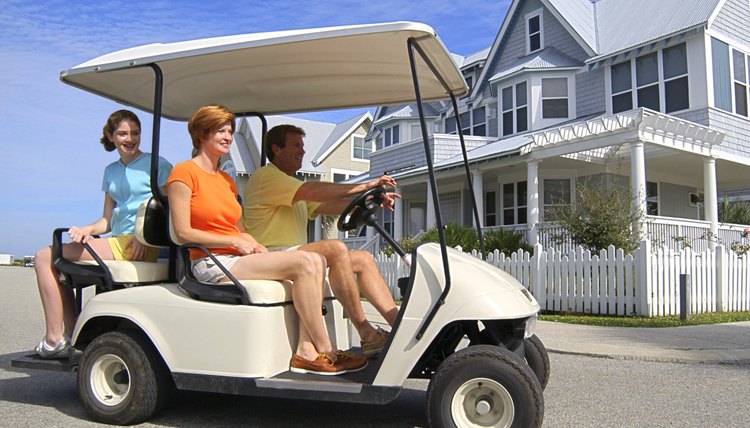How to Rebuild a Club Cart Motor

Club car motors are used to power golf carts. These engines are made to withstand about 100,000 hours of use. When the engine becomes difficult to start or you experience a loss of power and oil compression, you may need to rebuild the club car motor. By rebuilding the motor, you can avoid having to buy a new one.
Disconnect the muffler, cables and any other component that attaches to the club cart motor. Unfasten the bolts that hold the motor to the mount. Pull the motor from the golf cart.
Remove all of the 10,12 and 14 millimeter motor head bolts you see, using a screwdriver and socket-wrench. Remove caked on dirt and grease from the motor covers using a damp cloth dipped in water. Get the motor as clean as you can so you can identify the different bolts.
Detach the piston housing to access the cylinder and piston. Feel and move the piston to see if there is slack. A good piston will not have any slack. Locate and remove the four cylinder bolts that hold it to the motor. These are located at the bottom of the cylinder. Pull the cylinder off and pull out the piston to see if the piston rings need replacing.
Remove the piston pin with the snap ring pliers. Remove any dirt from the outside of the case with an aspirator or vacuum to prevent it from falling into the crank case. Insert a rag in the crank case hole to protect it from dirt and debris.
Disassemble the piston from the rod by inserting a 7/16 socket in the piston hole. Tap it with a small hammer to get it to insert fully. Hold the piston with your other hand to keep the pressure off the rod. Remove with the socket-wrench.
Remove broken piston rings by pulling out the old ones. In most cases the piston rings can be removed with your fingers, but you may need pliers to help. Insert the new ring and carefully work it around the piston.
Lift the remaining pieces of the base gasket from the housing base. Remove the bearings from the rod hole. Clean the bearings and housing base by spraying engine cleaner on the area. Allow the cleaner to set for a few minutes before wiping it off with a clean rag. Sand the gaskets with 400 grit sandpaper to remove any remaining dirt and debris.
Reattach the bearings and piston to the rod. Add a small amount of transmission oil to lubricate these parts.
Add a small amount of silicone to the base where the new base gasket goes. Push the gasket into the silicone and squeeze more silicone on top of the gasket to create a thin sealing film. Clean the cylinder housing you removed, coat it with transmission oil and replace it. Tighten the four bolts that hold the housing. This keeps the oil from spilling out.
Place the piston side into the carburetor hole of the engine. Align the other side to the exhaust port. Replace the head gasket and tighten the bolts evenly. Replace the motor and add oil to lubricate the piston and cylinder.
Tips
Videotape your work -- or diagram the parts -- as you perform the motor rebuild to ensure accuracy.
References
Tips
- Videotape your work -- or diagram the parts -- as you perform the motor rebuild to ensure accuracy.
Writer Bio
Jennifer Moore began writing in 2006, specializing in Web content, blogs and forum postings. She is a graduate from the most prestigious university in Mexico, Universidad de Las Americas, with a B.A. in international relations, later obtaining a U.S. teacher's degree and an additional CompTIA A+ certification in computer technology. Moore has written for My Mexico Living, BoomersAbroad and various other websites.
